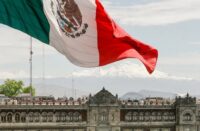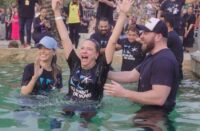Originally published in Assist News

The first believer among the Waodani, previously known as Auca, language community in Ecuador, Dayuma Caento, died on March 1, 2014. According to a missionary prayer update from Wycliffe associates, she was approximately 80 years old. In 1956, five missionaries lost their lives attempting to make contact with this group. Two years later, God used Dayuma to open the way for Elizabeth Elliot and Rachel Saint to begin language work among the Waodani. Dayuma helped to build a cultural bridge between the Waodani and the rest of the world. She also served with Rachel Saint in translating the Waodani New Testament.
An entry on Wikipedia says that Dayuma was a member of the Huaorani tribe and a citizen of Ecuador. She was a central figure in the Operation Auca saga, in that she was the first Huao convert to Christianity, as well as the missionaries’ key to unlocking the Huaorani language, a language that had not been previously studied. Later Dayuma also became an influential figure in her tribe.
Wikipedia says Dayuma was born sometime in the early 1930s in the rainforest of eastern Ecuador. As a member of the Huaorani tribe, she grew up in one of the most violent societies known to anthropology. When she was young, her family was terrorized by a Huao warrior named Moipa, who had attacked and speared many of her family. On one occasion, her father was mortally wounded in an attack. This prompted Dayuma to flee from her tribe, along with two other girls, and to go live with the more friendly Quechua Indians. Many of her family urged her not to leave, believing that all foreigners were cannibals, but Dayuma was convinced that her chances of survival were greater if she fled than if she stayed.
The Wikipedia entry says that when she came to a river at the edge of the jungle, Dayuma saw a group of foreigners coming down the river in canoes. As she crossed over to them, the men raised their guns to fire at her, but for whatever reason they did not. When Dayuma arrived safely on the other side of the river, she called back to the two other girls who had come with her, and they came over as well. It was then that she received clothes for the first time, since the Huaorani lived practically naked.
The article goes on to say that Dayuma lived outside of Huaorani territory on an hacienda for many years. There were many Quechuas there, as well as people from other places. Over time she began to assimilate with the Quechua language and culture. It was there that she was befriended by an American missionary named Rachel Saint, who took interest in learning the Huaorani language, also called “Huao Terero”. This language is unrelated to any other known language on earth, and had never been studied before this time. Dayuma was a great help to Saint, despite the fact that she had forgotten much of her language and did not speak English.
History
In 1955, Jim Elliot, along with four other male missionaries including Rachel’s brother, Nate Saint, were making plans to contact the Huaorani without Rachel’s knowledge. They met with Dayuma while Rachel was away and learned Huao phrases from her. When the men first arrived in Huaorani territory in early 1956, they were met by three friendly Huao Indians – a man and two women. One of the women was Dayuma’s sister, Gimade. One of the reasons she had come to meet with the missionaries was to see if they knew what had happened to her long-lost sister. Two days later, the men were killed by a larger group of Huao warriors, including some of Dayuma’s immediate family.

Not long afterwards, while still living at the hacienda and working closely with Rachel Saint, Dayuma became a Christian believer. Rachel Saint began to teach her more about the Bible and Dayuma continued to teach Rachel more of her language. Then in 1958, two women from Dayuma’s tribe emerged from the jungle and wanted her to return with them, telling her that her mother, Akawo, was still alive. Dayuma returned with them, and soon came back to the Quechua village with an invitation for Rachel Saint, along with Elisabeth Elliot and her three-year-old daughter Valerie, to come and live with them.
Thus began the first peaceful outside contact with the Huaorani tribe. Dayuma taught the language, and also was instrumental in converting much of her family to Christianity.
Elisabeth Elliot said of her: “Dayuma was the preacher.” The teachings of Christianity had a large effect on the tribe; most notably the number of homicides plunged by almost 90 percent. Dayuma also had learned to sew while she was living with the Quechuas, and she made clothes for her people. Dayuma lived with the Huaorani in the village of Tonampade, which is very near where the five missionary men were killed in 1956. It is also the location of theirs and Rachel Saint’s graves.
Operation Auca
Operation Auca was an attempt by the five Evangelical Christian missionaries from the United States to bring Christianity to the Huaorani people of the rainforest of Ecuador. The Huaorani, also known by the pejorative Aucas (a modification of awqa (Auca), the Quechua word for “savages”), were an isolated tribe known for their violence, against both their own people and outsiders who entered their territory. With the intention of being the first Christians to evangelize the previously uncontacted Huaorani, the missionaries began making regular flights over Huaorani settlements in September 1955, dropping gifts. After several months of exchanging gifts, on January 3, 1956, the missionaries established a camp at “Palm Beach”, a sandbar along the Curaray River, a few kilometres from Huaorani settlements. Their efforts came to an end on January 8, 1956, when all five—Jim Elliot, Nate Saint, Ed McCully, Peter Fleming, and Roger Youderian—were attacked and speared by a group of Huaorani warriors. The news of their deaths was broadcast around the world, and Life magazine covered the event with a photo essay.
The deaths of the men galvanized the missionary effort in the United States, sparking an outpouring of funding for evangelization efforts around the world. Their work is still frequently remembered in evangelical publications, and in 2006 was the subject of the film production End of the Spear. Several years after the death of the men, the widow of Jim Elliot, Elisabeth, and the sister of Nate Saint, Rachel, returned to Ecuador as missionaries with the Summer Institute of Linguistics (now SIL International) to live among the Huaorani. This eventually led to the conversion of many, including some of those involved in the killing. While largely eliminating tribal violence, their efforts exposed the tribe to increased influence from the outside.






